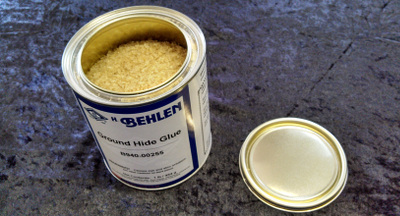Master Hand Violin Shop
Store Hours
Owner
Elizabeth Ecklund
Elizabeth Ecklund
By now you probably have realized that stringed instruments routinely get cracks that need to be repaired. If you bring in your cracked instrument for a repair estimate at Master Hand, you probably* won't be asked how your instrument cracked. We know that sometimes instruments crack through no fault of the owners. The important issues to discuss are the ones on your mind: how you should go about fixing your instrument, and why you should consider paying us to fix it.
The number one glue and, incidentally, the number one reason you should consider paying us to fix your cracked instrument, is hoof and hide glue. Hoof and hide glue is the only glue that should ever be used on any part of your instrument that may ever need to be unglued in the future (such as seams, nuts, saddles, etc). It is the standard glue of all luthiers because it has just the right properties: it shrinks when it dries, pulling the instrument together, it is a weak glue, allowing it to be unglued at a later date as necessary, and it does not run all over the instrument when it is applied properly.
How do we make and use such wonderful glue? Well, we don't *make* the glue, as hoof and hide glue is made from ground animal connective tissues in a factory far away. Rather, it comes to us as granules that we reconstitute in water and then heat over boiling water when we are ready to glue. The glue must be applied with a blade while it is still hot. The glue cools quite quickly. It can be briefly reheated, but after reconstitution it will begin to lose its stickiness (and if you are really lucky, it will also grow bacteria and turn green!). Hoof and hide glue comes as granules because it does not have a shelf life in liquid form; you must expect to make fresh glue often.

Hoof and hide glue is not the only option for repairs; wood glue is occasionally used on instruments, and it requires substantially less effort than hoof and hide glue to procure and use. Wood glue can be used for top cracks and other repairs that should never be unglued. Please note that if you work a little wood glue into a top crack and clamp your instrument incorrectly, the crck will be very difficult to correct. Epoxy should never be used. Nailing your instrument together should also never be done unless you are a music school teacher nailing together a school bass that it too cheap to warrant actual repairwork.
The number two reason that you should at least consider paying us to do your repairwork is that once the appropriate glue is applied, we have all the right clamps and know how to keep all the parts of the instrument level so that they dry beautifully. Have you ever tried to reglue a fingerboard? On a bass? Clamping the round surface of the neck? It's surprisingly not easy.
So now you should know all there is to know about glue that you can use on your stringed instrument. Hoof and hide glue yes, wood glue possibly, epoxy no.
------------------------------------------------------------------------------------------------------------
*Unless you have such an interesting crack that we just can't help ourselves. It's very hard to wonder if you *really* dropped a stack of folding chairs on your viola.
Share on Facebook